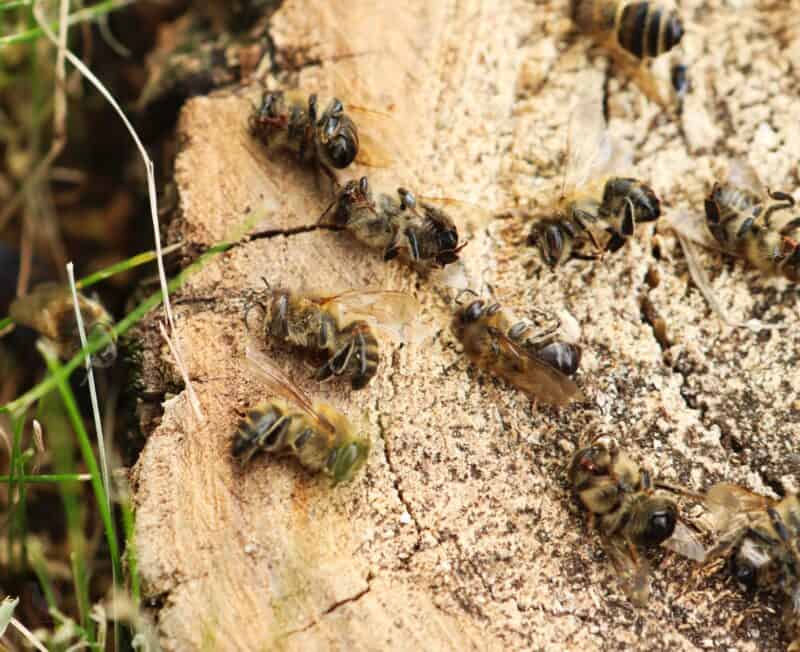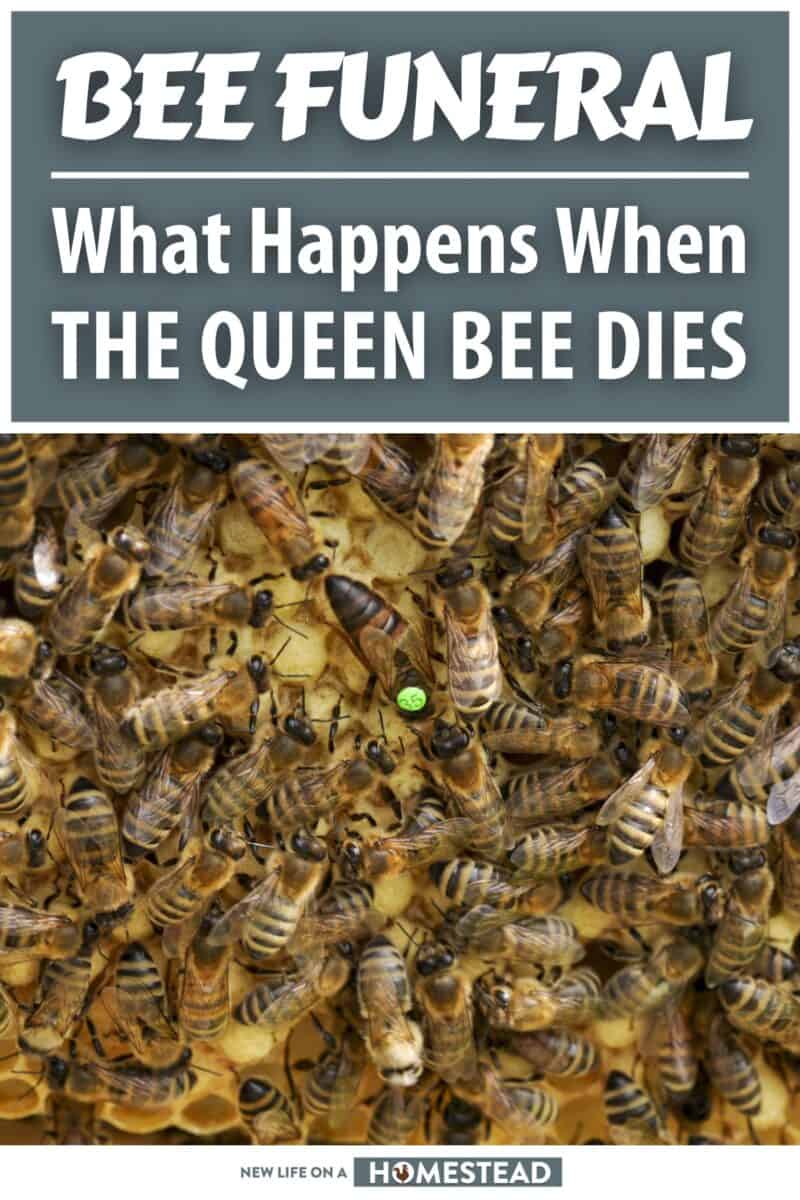No bee hive can exist for long without its queen. When a queen bee dies, the hive goes into a kind of shock. Vital direction is lost. Replacement numbers dwindle.

The bees soon know that they are in trouble when their queen is gone, and they start to take action…
In this article, we will explore what happens when the queen bee dies, and how it affects the rest of the hive.
We will also discuss what beekeepers can do to preserve and help the hive after the queen’s death. If you want to try and save your hive from the loss of its queen, keep reading.
The Importance of the Queen Bee to the Colony
Just how important is the queen bee to her hive of subjects? To say she is absolutely critical is an understatement!
As the name suggests, the queen bee is the most important member of the hive. She is responsible for laying eggs and ensuring that the colony has a steady supply of new bees, and workers in particular.
The queen also produces pheromones that help keep the colony together, calm, and functioning smoothly.
The queen’s pheromones regulate the biological functions of drones and workers, and also provide overall direction to the efforts of the colony.
Without a queen, the colony will soon fall apart for lack of both workers and harmony. Resource gathering slows down, and the bees might even become directionless.
So where does she come from, and how does she get into this position? A queen bee is born from an egg that has been fertilized by a drone (or male) bee.
The resulting larva is larger than that of a worker bee, and it is given more royal jelly during its development.
Once the new queen emerges and grows to adulthood she will go on a mating flight with several drones in tow.
During this flight, she will collect sperm from the drones, and store it in her spermatheca. This sperm will last her entire lifetime, or rather, entire reign as the acting queen of the hive.
The eggs she lays will hatch into either drones or worker bees. The sex of the bee is determined by the type of cell in which the egg is laid. Drones are born in larger cells, while workers are born in smaller cells.
The colony will only have one queen at a time. Eventually, one way or another, a queen dies and the colony faces a turning point…
Why Do Queen Bees Die?
The life of a queen bee isn’t an easy… She works tirelessly to lay eggs and keep the colony going. However, there are several reasons why a queen bee might die.
One common cause of death is old age. A queen bee can live for up to 5 years, but most live for 2 or 3 years.
As a queen ages, her egg-laying ability starts to decline. This can be a problem for the colony because it needs a steady supply of new bees to replace those that die or leave.
Without a steady influx of new generations, a hive enters decline and eventually collapses.
Queen bees can also be killed by other members of the hive.
If the colony isn’t doing well, either from a lack of organization or a lack of replacement workers, the workers may kill the current queen and replace her with a younger one. They’ll do this by looking for larva that are of the right age, hoping one of them will be the new queen…
This process, called supersedure, is a way for the colony to try to improve its chances of survival.
Queen bees, like every other bee, may die from disease or injury. Diseases that affect bees, such as foulbrood and nosema, can kill a queen just like they can kill workers and drones.
Injuries sustained during mating flights or from fighting with other queens or predators can also be fatal.
If you are a beekeeper, you must be careful not to introduce diseases into the hive…
The death of the queen bee is a big deal for the colony, probably the biggest save only physical destruction of the hive.
One way or another, a queen will eventually die despite her importance and without a queen the entire colony will soon die out. But don’t worry; the bees know what to do.
When a queen dies, the colony loses not only its leader, but also her pheromones…
The queen’s pheromones (a.k.a the queen ‘s scent) are important for regulating the biological functions of drones and workers, and they also provide direction to the colony as a whole.
What Exactly Happens When She Dies?
When the other bees notice their queen is gone, they start searching for a new one by looking for eggs that have been laid in queen cups.
Queen cups are special cells that are larger than normal worker cells and easily distinguishable.
If they find an egg in a queen cup, they will feed it extra royal jelly and care for it until it hatches into a new queen bee.
Once the new queen bee hatches, she will go on a mating flight and collect sperm from drones as described above and after she returns to the hive, she will start laying eggs and producing pheromones to rally the colony.
Assuming the numbers of the workers did not plunge too low during the absence of their former queen the colony will soon be back to normal. Whew! Disaster averted.
However, if the worker bees cannot find an egg in a queen cup, they will try to create a new queen “from scratch” by feeding royal jelly to a normal worker larva.
All larva get fed with this substance, but the selected successor queen will get extra portions that will trigger the biological changes that actually make the queen.
This larva will develop further than others, into a queen bee, and hopefully she’ll be as good as one that is born from an egg in a queen cup.
In any case, it can take up to 16 days for a new queen bee to hatch from an egg, and a few weeks after that until she is laying eggs full-time.
During this time, the colony will be without her guiding pheromones and in a vulnerable position, still generally disorganized and vulnerable to attack from other colonies or predators.
A Queen-less Colony will Eventually Perish
A colony that is forced to go without a queen in command won’t last long. The worker bees will try their best to find or create a new queen, but they can only do so much.
In the meantime, the colony will be without overall direction, highly disorganized and dying off. Without a steady supply of new bees being born, the colony will soon collapse.
So what happens to your bee colony when it cannot replace its queen?
Fewer workers means reduced production. Reduced production means bees and larvae alike can starve.
Fewer bodies in the hive means a reduced internal temperature, and that further stresses bees. In cold weather, this factor alone means certain death for the entire colony.
Sometimes, colony collapse from the loss of a queen is unavoidable, but much of the time, with a little luck and a lot of know-how, you can help your hive survive this tumultuous time.
What Can You do to Help Replace a Lost Queen?
If you are caring for a hive of bees, you need to be aware of what happens when the queen bee dies.
You’ll need to be on the lookout for the changes in behavior and productivity that signal trouble.
With enough knowledge and preparation, you can help the hive through this difficult time of transition and (hopeful!) renewal.
The first step is to check on the queen. Is she really dead, or just missing?
If she’s just missing, there’s a chance she’ll turn up later. This is especially common with large hives with big populations.
If she’s definitely dead or dying, then you may need to take action to help the hive replace her.
If a colony is struggling, specifically through lack of egg laying or laying of viable eggs, you might decide to euthanize the ailing queen.
This will prompt the bees to respond by replacing her sooner rather than later.
Once the queen is dead, the first step for you is to make sure the hive has enough bees. If it does and is not otherwise stressed, they’ll probably replace their queen on their own with few problems.
But a colony that is already struggling in the immediate aftermath of queen’s death may not have enough bees left to create a new queen. This is where you’ll definitely need to take action to help them…
In this case, you should provide a frame of eggs and larvae from another hive for the bees to use in creating their new queen.
As a last resort, you can always buy a new queen, though whether the rest of the bees accept isn’t guaranteed. This is why you should let them choose their own queen if possible.
If the hive has enough bees but they are struggling to create a new queen, then you might provide them with a “ready-made” queen from another hive.
Although not the best choice, it is a viable way to ensure a mature queen is at least at the helm.
The bees will need to be introduced to her slowly, but if all goes well, she should be accepted and get to work laying eggs for her adopted and no-loyal subjects.
Once the new queen is in place, accepted, and laying you can sit back and let nature take its course! With a little luck, the hive will soon be back to normal, growing and producing honey as before.
The Queen is Dead, Long Live the Queen!
Opening a hive and finding that the queen is missing or dead is never a good feeling when you are a beekeeper, but it is a major crisis for the other bees.
By being prepared and knowing what to do, it doesn’t have to mean the end of the hive and the deaths of your workers.
With a little help from their human friends, bees can overcome this setback and carry on with their busy lives.

Tom has lived and worked on farms and homesteads from the Carolinas to Kentucky and beyond. He is passionate about helping people prepare for tough times by embracing lifestyles of self-sufficiency.
